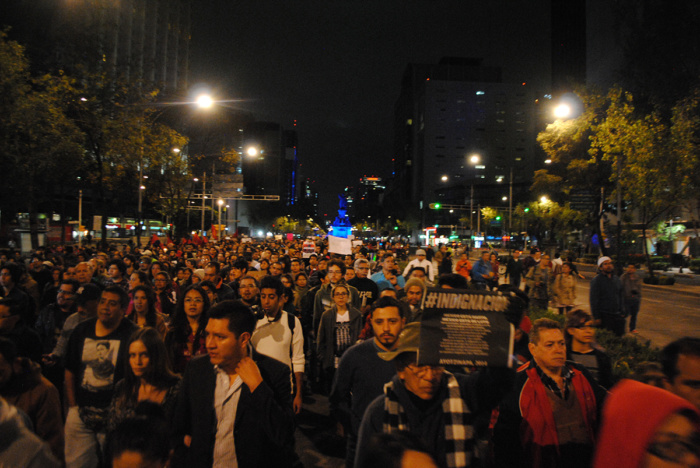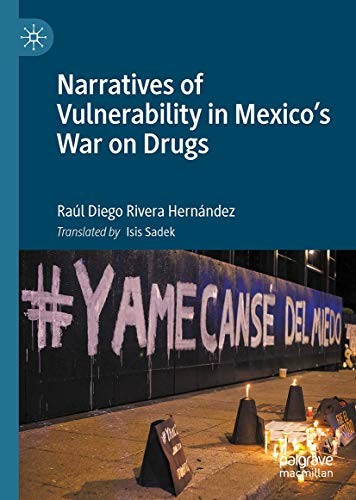Narratives of Vulnerability in Mexico, by Raúl Diego Rivera Hernández, translated by Isis Sadek.
Published by Palgrave Macmillan (2020) ISBN 978-3-030-51144-9.
People in the United States are familiar with the U.S. war on drugs but less so with Mexico’s and, even less with the extent of U.S. involvement in the latter. As any war, the drug war also has countless victims of the violence simultaneously unleashed by both the drug cartels and government forces upon Mexicans and Central American migrants passing through Mexico. Narratives of Vulnerability in Mexico’s War on Drugs written by Raúl Diego Rivera Hernández and artfully translated to English by Isis Sadek chronicles the history of this violence and the plight of its victims.
History, it has been rightfully stated countless times, is written by the victors, and by the powerful. The oppressed, the poor, women, children, indigenous populations, are often forgotten, or disregarded as so-called “collateral damage”. It is partly why this book is so invaluable because it brings to the forefront the consequences of the drug war we see only in news headlines, Hollywoodesque film series and documentaries but in reality, it is suffered by individuals who have no part in it, yet who are the nameless victims of the violence it causes. One way to empower victims is to name them, just like they do in Black Lives Matter chants: “say her/his name!” and to tell their story, thus giving them an individuality that leads us, the readers, to empathise with each victim. “One death is a tragedy, a million deaths a statistic.” This saying has been attributed to several people, most notoriously to Joseph Stalin (who would know it from real experience…). A poignant illustration of this is the Covid pandemic that killed over one million people in the world. Victims should not be forgotten and placed in the dustbin of history. Everyone is someone’s child, parent, brother, relative, friend. Every human life is equally valuable. No one illustrated this better than 17th century English poet, John Donne, eternalised in the epigraph of Hemingway’s For Whom the Bell Tolls:
any man’s death diminishes me, because I am involved in Mankinde; And therefore, never send to know for whom the bell tolls; It tolls for thee.
For Whom the Bell Tolls, Ernest Hemingway (1940).
Beyond chronicling sad victim-stories, the author also celebrates the courage and the bravery of the people who are making sacrifices to uncover the truth and run grave risks in their resistance to the most powerful forces on either side of the drug war. This book is a hopeful and positive account of resistance and survival amid injustice of oppression and the horrors of often random violence. Vulnerability in the title of the book does not reflect weakness but a certain defencelessness. Citizens of a country should be protected by their government and by the institutions of the State against violence caused by criminal elements. Instead, what we have seen in Mexico: a government that abandoned its responsibility to citizens and lets women, journalists, bystanders die the thousands and, in some instances, it even partakes in and profits from criminal activity, instead of using its powers to shield the people from it.
Discourses of power are often articulated by euphemisms. Violent repressions of dissent are often described as matters of “national security,” excesses of power (by the police and the military) are referred to as “maintaining law and order.” Narratives of Vulnerability challenges these concepts and exposes their falsehoods. The Mexican government’s strategy to confront the viciousness of drug cartels was to escalate the violence whereby innocent civilians, called by the 2 author “vulnerable subjects,” were caught in the middle and became sufferers of abuses by either side. This policy, evidently a failure, has cost more than 300,000 lives in Mexico since 2006.
According to the 1948 Universal Declaration of Human Rights by the United Nations, to which societies supposed to adhere today, human rights are:
inherent to all human beings regardless of race, sex, nationality, ethnicity, language, religion, or any other status. Human rights include the right to life and liberty, freedom from slavery and torture, freedom of opinion and expression, the right to work and education, and many more
Universal Declaration of Human Rights by the United Nations (1948).
These rights are being violated daily in Mexico (and many other places) to such an extent that some scholars, among them Alejandro Anaya Muñoz and Barbara Frey, consider it “unparalleled in the country’s recent history”. Why “recent” history? Because Mexico had its share of bloodshed throughout its history, starting with pre-Columbian conflicts, followed by Spanish colonisation in the 16th century, the Independence War from Spain in the 19th, the 10-year Mexican revolution in the early 20th centuries and now this extended war on drugs to mention just the most prominent historical moments. One of the reasons why the war on drugs lasts so long is the lack of accountability of the perpetrators. One judicial instrument of accountability proposed in the book is the so-called “transitional justice” that includes a series of legal tools to deal with a crisis of this magnitude. These may include Truth and Reconciliation Commissions, criminal prosecutions, reparation programs and other legal remedies.

Mexico’s war on drugs was initiated following the U.S. model formally started by President Nixon in 1971. After Nixon’s speech declaring drugs as “America’s number one enemy”, the press coined the phrase: war on drugs. Contrary to the popular belief that the war on drugs in Mexico was initiated only in the 1990s when Colombian drug cartels moved their operations to Mexico, Narratives of Vulnerability gives a clear historical account of the initial phases of the drug war during the cold war in the 1970s when U.S. expansionist policies toward Latin America, including Mexico, code-named Operation Condor were carried out by the Johnson, Nixon, Ford, Carter, and Reagan administrations for over two decades. In Mexico, after the 70-year rule of the Institutional Revolutionary Party (PRI) growing democratisation allowed other parties access to power and the intimate link between the government and the drug trafficking organisations (DTO) was starting to disintegrate. The post-PRI governments were not able or willing to negotiate with the DTOs as effectively as the PRI did, and proposed instead their obliteration. However, they under-estimated the DTO’s strength and the corruptibility of government officials from the lowest to the highest levels and lost control over the DTOs. This coincided with two other factors: the growing demand for cocaine as the drug of choice in the U.S., and the increasing U.S. intervention in Colombia’s drug war that culminated in the killing of Pablo Escobar in 1993, that forced the cartels to look for alliances with drug trafficking organisations in other countries. Mexico’s proximity to the main drug market made it the perfect choice. The increasingly militarised fight against DTOs in Mexico by the Fox and Calderón administrations (2000-2012) claimed many civilian victims subsequently dehumanised by the perpetrators, their death being qualified as “collateral damage”, or worse, as the killing of drug kingpins and touted by government forces as evidence for their military success over the DTO’s. Public mourning of victims was forcefully discouraged by the State that branded these acts as signs of collaboration with the DTOs. In 2011, however, something changed. With the killing of the son of a well-known poet, Javier Sicilia, the politization of public pain begun. The foundation of Movement for Peace with Justice and Dignity and its support for The Caravan for Peace in the US in 2012, that crossed 14 states and stopped in 27 cities illustrated the transnational nature of the war on drugs, while emphasising the economic roots of the problem: 3 the link between neoliberal policies and the escalating violence in Mexico that continues until today with very little, or no accountability.
The theoretical framework of Narratives of Vulnerability is based upon the philosopher, Judith Butler’s concept, whereby vulnerability is a collectively shared condition that affects certain segments of the population more than others contingent upon the possession of power. A body, Butler states, is that of an individual but also a social phenomenon, as in body politic, for example. Vulnerability of an individual is easy to understand but its effects on the social body, the community at large is a cardinal question thoroughly dealt with in this book.
As detailed in chapter 2, violence in Mexico does not mark only Mexicans, it also affects Central American migrants who cross Mexico on their way to the US fleeing the violence in their own country. In 1980s Central America was the focus of US activities fuelled by the cold war. The backing of the Nicaraguan Contras, the military support of various dictatorships in Guatemala and El Salvador were examples of covert and unconcealed US interventions in Central America, such as the one in Panama in 1989. Millions fled the violence in those countries finding their way to the US (their plight is exemplified in the film, El Norte). However, the children of immigrants who made it to US cities, already traumatised by the violence and not properly supervised by their parents who had to work several jobs to make end’s meat, joined violent gangs which (they felt) offered them a home, a place to belong to. With the increasing enforcement of U.S. immigration laws and the growing number of deportations in the late 1990s many of these children (who were grownups by then) found themselves in their country of origin they barely knew (or not at all). But there, they continued the only “profession” they knew how to do: gangs. Today Guatemala, Honduras and El Salvador are the most dangerous countries in Latin America where gangs rule, constantly threaten public safety and recruit children as young as 10-12 years old. To avoid recruitment, parents of targeted children fled the country with them or sent them alone to the US. This is how a large number of unaccompanied children showed up at the US border during the Obama administration in 2014 and ever since.
Mexico’s war on drugs has been widely represented in different cultural products, scholarly books, novels, films, documentaries and series. Narratives of Vulnerability draws upon an impressive variety of mediatic forms and discourses (journalistic, memorialistic, legal, historic and narrative), as well as social media, audio and visual materials to illustrate the plight of the often nameless victims whom Diego Rivera Hernández calls “vulnerable subjects,” a denomination more appropriate than victim, to divert attention from victimhood to subjecthood thus humanising the subjects of collective suffering.

In Mexico, one of the most horrific cases is the 2014 disappearance of 43 college students from the Ayotzinapa Teachers’ College of Tixtla in the State of Guerrero, discussed at length in chapter 4 of the book. Beyond the fact that the mass disappearance of 43 young men is a tragedy of Biblical proportions, it also exemplifies the active collaboration between local, state and federal police, as well as the military, with organised crime that counters the notion of having two sides in this war on drugs fighting each other. The recent arrest of Salvador Cienfuegos Zepeda, Mexico’s defence secretary under former President, Enrique Peña Nieto (2012-2018) dubbed “El Padrino” (the “Godfather”), on drug charges proves this collaboration. Narratives of Vulnerability successfully incorporates all the complexities in the thorough analysis of these events and shows the alliance of some forces that are supposed to be on opposite sides in the drug war.
One of the many consequences of the violence is the transformation of those who lost loved ones, into “experts without credentials”. The term seems to echo John Beverly’s 4 characterisation of Rigoberta Menchú Tum as an “organic intellectual”. The Guatemalan indigenous organiser and the 1992 Nobel Peace Prize recipient was propelled to be a leader by a history of losses and tragedies touching her life, as well as those of her community. Who are these “experts without credentials”? The parents and relatives of the disappeared and murdered who are searching for answers that government officials are unable or unwilling to give them. To have some closure, they need to know what happened to their loved ones. In their extended search they become parts of advocacy groups and learn about forensic techniques and other research methods. This work is not without risk. Those in office who have something to hide will use their power to forcefully suppress these inquiries. However, the desire for the truth defies the risks and investigations by family members continue with the help of journalists who literally put their lives on the line to discover the truth, as discussed in chapter 3 of the book. According to the International Federation of Journalists, in 2019 Mexico was the deadliest country for journalists, even more so than countries at war, like Syria or Afghanistan.
Narratives of Vulnerability is an excellent historical analysis of human rights violations, as well as a thoughtful scrutiny of literary and filmic representation of the violence that still rages in Mexico and Central America. But it is also a hopeful celebration of courage and solidarity and of the value and sanctity of all human lives.


